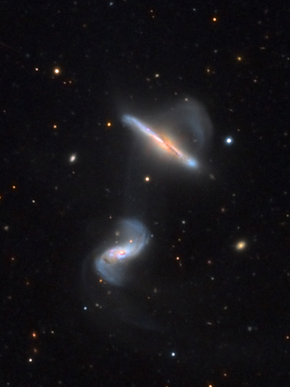NGC 6285
| NGC 6285 | |
|---|---|
 NGC 6285 (below) and NGC 6286 (above) as seen through the 0.81 m Schulman Telescope at Mount Lemmon Observatory. | |
| Observation data (J2000 epoch) | |
| Constellation | Draco |
| Right ascension | 16h 58m 24s |
| Declination | +58° 57′ 21″ |
| Redshift | 0.018983±0.000160 |
| Heliocentric radial velocity | 5691±48 km/s |
| Galactocentric velocity | 5880±49 km/s |
| Distance | 262 million light years |
| Apparent magnitude (V) | 14.48 +/- 0.15 |
| Absolute magnitude (V) | -20.00 +/- 0.52 |
| Characteristics | |
| Type | S0-a |
| Size | 91,000 light years |
| Apparent size (V) | 1.20′ × 0.7′ |
| Other designations | |
| MCG 10-24-81, ZWG 299.37, ARP 293, PGC 59344 and KAZ 111 | |
References: NASA/IPAC extragalactic datatbase, http://spider.seds.org/ | |
NGC 6285 is an interacting spiral galaxy located in the constellation Draco. It is designated as S0-a in the galaxy morphological classification scheme and was discovered by the American astronomer Lewis A. Swift in 1886. NGC 6285 is located at about 262 million light years away from earth. NGC 6285 and NGC 6286 form a pair of interacting galaxies, with tidal distortions, categorized as Arp 293 in the Arp Atlas of Peculiar Galaxies[1][2][3][4]

See also
References
- ^ "Object No. 1 - NGC 6285". NASA/IPAC. Retrieved 4 October 2015.
- ^ "Revised NGC Data for NGC 6285". Seds. Retrieved 4 October 2015.
- ^ "NGC 6285 (= PGC 59344, and with NGC 6286 = Arp 293)". cseligman. Retrieved 4 October 2015.
- ^ "NGC 6286 & NGC 6285". PBase. Retrieved 4 October 2015.
External links
 Media related to NGC 6285 at Wikimedia Commons
Media related to NGC 6285 at Wikimedia Commons
